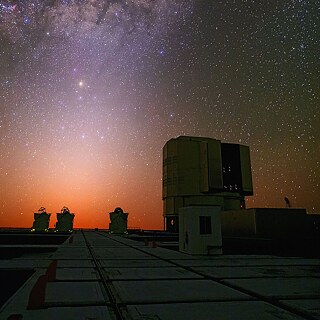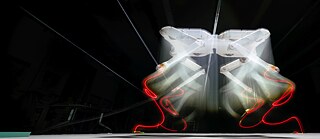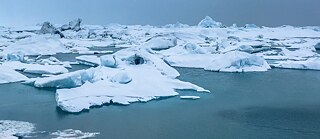
Our climate in crisis
The average global temperature has risen by about one degree in the past 200 years. That doesn’t sound like much – but compared with levels over the past 12,000 years it’s a very sharp rise.
Climate change is a fact and it’s caused by humans. 99 per cent of specialists are saying that. The World Climate Council understands that climate change is primarily caused by greenhouse gas emissions – mainly by the emission of carbon dioxide (CO2) from the combustion of coal, oil and natural gas. But the production of animal-based food products plays a major role as well.
Many people are now calling for rapid action, for instance the young Swede Greta Thunberg. Then aged 15, she began her School Strike for Climate in 2018, and it developed into an international movement. For “Fridays for Future” the climate crisis is one of the main challenges of the 21st century.
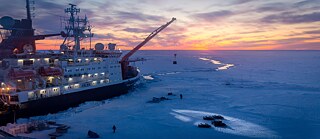
© Stefan Hendricks / Alfred-Wegener-Institut / CC BY-SA 4.0
Analysis of the data gathered will take years yet. But some things are clear already. The temperatures in winter 2019/20 were around ten degrees Celsius above those measured by polar researcher Fridtjof Nansen a good 125 years ago – that’s high-speed climate change.
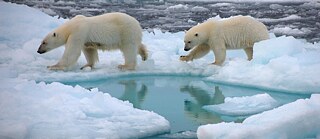
© Dirk Notz
For every tonne of carbon dioxide released somewhere on our Earth, the summer sea ice in the Arctic is reduced by three square metres. That’s the result of an international study led by Dirk Notz, climate researcher at the Max Planck Institute for Meteorology and at the University of Hamburg. So far, the North Pole is still covered all year round by sea ice. Every summer the ice sheet shrinks, in winter it grows again. But in the last 40 years the area covered by the summertime Arctic sea ice has approximately halved. And calculations by the researchers show: even if we quickly reduce CO2 emissions, the Arctic will already be ice-free in some summers by the middle of this century. As the ice area becomes smaller, less of the sun’s radiation is reflected and it’s absorbed by the ocean instead. The water becomes warmer. In winter, the ice separates the relatively warm water from the much colder air, otherwise the ocean would give off huge amounts of heat.
 © Max-Planck-Gesellschaft
© Max-Planck-Gesellschaft
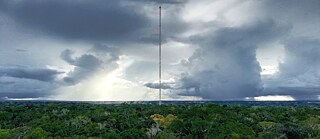
© Sebastian Brill / Max Planck Institute for Chemistry, Mainz
The Amazon forests in Brazil habe a major significance for the climate of the Earth. They account for just four per cent of the land area, but they move large amounts of water and energy. A German-Brazilian cooperation project is investigating the ways in which the forests influence the atmosphere and the global climate. The cornerstone of this project is the “Atmospheric Tall Tower Observatory”, known as ATTO for short. This 325-metre tower stands in the middle of the rainforest – far away from any civilisation. State-of-the-art measuring equipment constantly gathers data on the concentration of greenhouse gases and aerosol particles, cloud properties and air movements. This allows researchers to analyse the interrelationships between the forest and the air masses that move over it. The ATTO project is coordinated by Susan Trumbore, Director at the Max Planck Institute for Biogeochemistry in Jena, and Beto Quesada at INPA in Manaus.
 © Max-Planck-Gesellschaft
© Max-Planck-Gesellschaft

© German Future Prize/Ansgar Pudenz
All raw materials that contain carbon end up as the greenhouse gas CO2 in the atmosphere at some point. For this reason one necessary step is to reduce the use of fossil fuels. At the same time the chemical industry needs a large amount of carbon as a raw material from which to make products. These days mineral oil is generally used for this purpose. Walter Leitner from the Max Planck Institute for Chemical Energy Conversion in Mülheim and his team want to replace it with CO2, so that the carbon dioxide already in existence is used wisely. However it isn’t that easy to turn climate-damaging CO2 into a raw material. The trouble is that the bond between carbon and oxygen is very stable. To break it you need a lot of energy. Catalysts help here. They reduce the energy requirement for a chemical reaction and guide it in the desired direction. The scientists from Mülheim are developing specific catalysts to combine CO2 with hydrogen and other chemical building blocks.
Many people are now calling for rapid action, for instance the young Swede Greta Thunberg. Then aged 15, she began her School Strike for Climate in 2018, and it developed into an international movement. For “Fridays for Future” the climate crisis is one of the main challenges of the 21st century.
Frozen in polar ice
Nowhere is climate change so clearly visible as in the Arctic. That’s why the Alfred Wegener Institute for Polar and Marine Research started the biggest Arctic expedition of all time in October 2019. For one year the research vessel “Polarstern” was frozen in a huge ice floe at the North Pole. Scientists from 20 nations researched the Arctic in the area surrounding the ship throughout the year.
Analysis of the data gathered will take years yet. But some things are clear already. The temperatures in winter 2019/20 were around ten degrees Celsius above those measured by polar researcher Fridtjof Nansen a good 125 years ago – that’s high-speed climate change.
The Arctic without ice?

For every tonne of carbon dioxide released somewhere on our Earth, the summer sea ice in the Arctic is reduced by three square metres. That’s the result of an international study led by Dirk Notz, climate researcher at the Max Planck Institute for Meteorology and at the University of Hamburg. So far, the North Pole is still covered all year round by sea ice. Every summer the ice sheet shrinks, in winter it grows again. But in the last 40 years the area covered by the summertime Arctic sea ice has approximately halved. And calculations by the researchers show: even if we quickly reduce CO2 emissions, the Arctic will already be ice-free in some summers by the middle of this century. As the ice area becomes smaller, less of the sun’s radiation is reflected and it’s absorbed by the ocean instead. The water becomes warmer. In winter, the ice separates the relatively warm water from the much colder air, otherwise the ocean would give off huge amounts of heat.

Research between the sky and the earth

The Amazon forests in Brazil habe a major significance for the climate of the Earth. They account for just four per cent of the land area, but they move large amounts of water and energy. A German-Brazilian cooperation project is investigating the ways in which the forests influence the atmosphere and the global climate. The cornerstone of this project is the “Atmospheric Tall Tower Observatory”, known as ATTO for short. This 325-metre tower stands in the middle of the rainforest – far away from any civilisation. State-of-the-art measuring equipment constantly gathers data on the concentration of greenhouse gases and aerosol particles, cloud properties and air movements. This allows researchers to analyse the interrelationships between the forest and the air masses that move over it. The ATTO project is coordinated by Susan Trumbore, Director at the Max Planck Institute for Biogeochemistry in Jena, and Beto Quesada at INPA in Manaus.

Using CO2 wisely

All raw materials that contain carbon end up as the greenhouse gas CO2 in the atmosphere at some point. For this reason one necessary step is to reduce the use of fossil fuels. At the same time the chemical industry needs a large amount of carbon as a raw material from which to make products. These days mineral oil is generally used for this purpose. Walter Leitner from the Max Planck Institute for Chemical Energy Conversion in Mülheim and his team want to replace it with CO2, so that the carbon dioxide already in existence is used wisely. However it isn’t that easy to turn climate-damaging CO2 into a raw material. The trouble is that the bond between carbon and oxygen is very stable. To break it you need a lot of energy. Catalysts help here. They reduce the energy requirement for a chemical reaction and guide it in the desired direction. The scientists from Mülheim are developing specific catalysts to combine CO2 with hydrogen and other chemical building blocks.
Cooperation partners

|

|
You might find this also interesting

